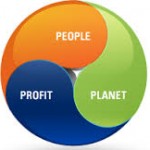(July’s guest blog post is by Stephanie Klein, PhD. I met Stephanie at a gathering of Minnesota Professionals for Psychology Applied to Work (MPPAW,) and I was happy to learn about her interest in the connection of environmental stewardship to organization effectiveness. – Al Watts)
by Stephanie Klein, PhD
Organizations employ many tools for crafting cultures that are effective, engaging and ethical; the goal of this article is to highlight the role that environmental sustainability can play. You may even discover that your organization has already established a foundation ready to build upon.
Many of you are familiar with the triple bottom line framework: People, Planet, Profit. Most organizations recognize the importance of people  (employees, community) and profit (even non-profits pursue financial health and stability), and monitor those diligently. Progressive organizations have also embedded positive sustainability-related change into their processes, recognizing not only their role as community stewards, but how environmental sustainability positively impacts organizational effectiveness and employee engagement.
(employees, community) and profit (even non-profits pursue financial health and stability), and monitor those diligently. Progressive organizations have also embedded positive sustainability-related change into their processes, recognizing not only their role as community stewards, but how environmental sustainability positively impacts organizational effectiveness and employee engagement.
Efforts to improve organizational effectiveness are typically focused on reducing wasted resources and improving efficiency. Attention to environmental factors is a natural extension of efforts along those lines, expanding perspectives on ways to conserve resources. Without consideration of environmental factors, some efforts to improve efficiency and effectiveness might in the long run actually waste resources and have a negative or neutral impact. Consideration of environmental factors expands our field of view for ways to improve efficiency and effectiveness by reducing consumption of natural resources and/or generation of pollutants. Consideration of environmental impact also resonates with a growing sentiment among workers and consumers who want to associate with those kinds of organizations.
The intent here is not to encourage anyone to step outside the boundaries of their professional arena. Measuring parts-per-million of pollutants in the wastewater, or calculating specific energy efficiencies, remains squarely in the domain of experts. Yet those of us advising organizations or working within organizations, especially if we play a role in strategic decision-making, are very well-positioned to guide sustainability-related change.
We may be designing programs ourselves, providing guidance, or have decision-making authority or influence. In all of these cases, the intent is typically to design programs or initiatives to achieve certain goals. And if the program is well-designed, we typically define those desired outcomes, and ideally plan to gather metrics for determining the extent that outcomes have been achieved. This article is about expanding our definition of “outcomes”to explicitly consider relevant environmental sustainability outcomes. Here are two examples:
Example One:
An organization initiated video-based interviewing for the second round of candidate interviews, typically the top 10 remaining after an initial phone conversation. The purpose of this shift in the recruiting process was two-fold: to improve recruiting process efficiencies and to reduce costs; both objectives were achieved. First, process efficiencies were realized because the recruiter  no longer needed to coordinate multiple interviewers being onsite on the same day as a candidate visit, and top candidates were less likely to be lost due to excessive delays in scheduling. Second, cost savings were significant; the company now funds travel for only the final two or three candidates to interview onsite. Though unanticipated, environmental impacts were also favorable, including a 70% reduction in the number of airline and car trips per open position, with a corresponding reduction in fuel consumed and CO2 emissions produced. The organization implemented the new interview approach to make the recruiting process more efficient and less costly, but this does not mean that it should deny itself credit for the resulting reduction in its carbon footprint.
no longer needed to coordinate multiple interviewers being onsite on the same day as a candidate visit, and top candidates were less likely to be lost due to excessive delays in scheduling. Second, cost savings were significant; the company now funds travel for only the final two or three candidates to interview onsite. Though unanticipated, environmental impacts were also favorable, including a 70% reduction in the number of airline and car trips per open position, with a corresponding reduction in fuel consumed and CO2 emissions produced. The organization implemented the new interview approach to make the recruiting process more efficient and less costly, but this does not mean that it should deny itself credit for the resulting reduction in its carbon footprint.
Example Two:
An organization redesigned its inventory management process to reduce costs related to waste (damaged and expired goods) and shipping (expensive last-minute delivery to deal with unexpected shortages). The process redesign succeeded by significantly reducing the number of discarded items and overnight orders, and reducing costs as intended. As in Example One, there were also positive environmental impacts. First, fewer discarded goods become trash, and raw materials and energy required to create replacements for the wasted goods are not required. Second, land transportation (train and truck) has less negative environmental impact than air transport, which is needed for overnight orders.
Estimates of environmental impact for initiatives like the examples above can be calculated using online tools such as https://www.carbonfund.org/business-calculator.
There are likely any number of similar opportunities in your own organization for becoming even better stewards while improving organizational efficiency and effectiveness. The proposal here is not to focus on environmental sustainability to the exclusion of other decision criteria, or even to give it priority against other strategic and logistical factors. Rather, you are encouraged to simply keep sustainability-related outcomes on the list of considerations when making decisions about which proposed process improvements or strategic initiatives to prioritize for investment, and to measure environmental impacts of decisions.
sustainability to the exclusion of other decision criteria, or even to give it priority against other strategic and logistical factors. Rather, you are encouraged to simply keep sustainability-related outcomes on the list of considerations when making decisions about which proposed process improvements or strategic initiatives to prioritize for investment, and to measure environmental impacts of decisions.
Over time, incremental changes in an organization’s environmental impact in aggregate will yield significant, measurable reductions in an organization’s carbon footprint. Meanwhile, organizations that focus on the environmental impact of their decisions and actions will embed stewardship as an enduring value of their culture, while earning the loyalty of customers and employees who increasingly seek it.
(Stephanie Klein, PhD, is an industrial-organizational psychologist specializing in organizational effectiveness and making strategy happen. Her recent publications include Green Organizations: Driving Change with I-O Psychology (available on Amazon, or use code IRK71 for a 20% discount on the publisher’s website), and “Organizational Responsibility,” an article in the Management topic of Oxford Bibliographies Online. Stephanie can be contacted via LinkedIn or email, srklein42(at)hotmail(dot)com
The ultimate test of a moral society is the kind of world that it leaves to its children.
Dietrich Bonhoeffer
No snowflake in an avalanche ever feels responsible.
George Burns
